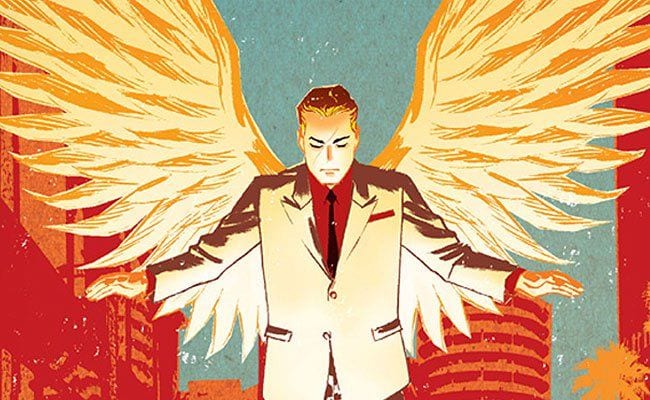
One of the most acclaimed and memorable titles to emerge from DC comics’ original Vertigo imprint was Mike Carey’s Lucifer, a spinoff of Neil Gaiman’s revolutionary comic, Sandman. Carey’s book took place after the events of Sandman, in which Lucifer has resigned the throne of Hell to take up residence on Earth. Opening a piano bar called “Lux” in Los Angeles, Lucifer continues his campaign against God and Heaven’s authority, meeting and confronting a wide cast of other deities and devils along the way.
The newest volume of Lucifer, penned by acclaimed fantasy writer Holly Black, not only brings back the iconic character, but is the first book in the new Vertigo imprint to reinstate the old Vertigo canon, reintroducing the established continuities of classic comic series such as Lucifer, Sandman, and Hellblazer. While this first issue doesn’t quite measure up to a typical issue of Carey’s masterful book, it demonstrates a great deal of promise as a worthy successor.
The issue begins by establishing a new status quo for Lucifer. After a period of absence since the end of the original series, in which Lucifer banished God (“The Presence”) from Heaven and gave control of the universe to a young girl, Elaine Belloc, the daughter of the archangel Michael, Lucifer returns to Los Angeles by characteristically falling from the sky. Building a new club, this time called Ex Lux, he resettles his old life, all the while sporting a mysterious wound in his side (reminiscent of a certain wound of a certain savior).
At the same time, two of Heaven’s angels arrive in Newark, New Jersey and enter a condemned home that’s become a drug den. There they find an unlikely resident: the archangel Gabriel, who has become a derelict since having his heart removed by John Constantine (as seen in the original Hellblazer comic), thus becoming mortal. The angels promise Gabriel a chance at reclaiming his heart, and therefore his grace, if he comes with them.
Bringing Gabriel to Heaven, they inform him that their father, God, is apparently dead. The angels assign Gabriel the task of tracking down God’s murderer as the angels try to reorder the universe and prevent news of God’s death from reaching the ears of other deities.
Gabriel’s first step is to find Lucifer, the natural suspect for the death of God. Confronting him at Ex Luc, Gabriel is instead surprised to find the wounded Lucifer, who expresses his own interest in tracking down God’s killer.
“Why would you do that?” Gabriel asks.
“Because nobody gets to kill God but me,” replies Lucifer.
“And because he was my father, too.”
Lucifer’s ever-complicated feelings towards his father, God, are expertly summed up in this one retort.
Lucifer contacts his old allies in Hell. A messenger demon runs to Hell’s capitol, Pandemonium, to inform Hell’s present ruler: the demon Mazikeen, Lucifer’s old associate and lover, who refuses to believe the news. Whether or not there is bad blood between the old allies remains to be seen.
In returning the world of Lucifer to Vertigo, Black’s script contains all the familiar elements and details that made the original series so spectacular. From Lucifer’s snide, nonchalant attitude to the motley cast of supernatural beings that inhabit Lucifer’s social circle (i.e., a bartender with a fly’s head) to the original series’ iconoclastic humor (“What do either of you know about temptation? Your idea of sin is snickering when a wheel-shaped cherub slips and rolls downhill”), Black’s first issue feels rightly like a Vertigo comic of old.

Perhaps the only hurdle the series finds itself facing is establishing a storyline on par with the scale and regular dynamism of Carey’s series, which famously included universal, dimensional adventures and conflict intermixed with more (literally) down to earth human drama. Following a storyline in which God is evicted from Heaven and the entire cosmos is reassigned is definitely not an easy act to follow, and while Black’s plot of “who killed God” is definitely no small story, this first issue establishes the setting more than demonstrates the immensity of such a premise. To put it in Lucifer-ian terms, the issue feels particularly grounded.
That said, the ground Black establishes is solid and reassuring. All of the elements needed for a competent Lucifer story are established, both in Heavenly and Earthly scale (i.e., the introduction of a few of the addicts from the drug then as part of the cast). Black’s script also pays homage to much of the Vertigo canon, and the acknowledgment, or at least mention, of its presence in the comic’s universe is nostalgically refreshing.
Whether it be the continuation of Gabriel’s story out of Ennis’ Hellblazer, or even slight nods to old series like Dead Boy Detectives (“Ask any child who wants to kill God and they’d say the devil” / “and that’s why children make such wonderful detectives”), the in-story presence of these old series and storylines is a pleasing return for a fictional world as immense and beloved as that of the old Vertigo comics. With any luck, this new volume of Lucifer will serve as a doorway to resurrecting some of those old series.
The artwork of Lee Garbett suitably depicts the wild world of Lucifer, and is detailed and expressive enough to capture the various faces and character designs the comic lends itself to. Hopefully as the series progresses, Garbett will have the chance to explore the vast, fantastical landscapes that were a trademark of the original series.
Lucifer #1 is a sigh of relief that a classic comic series is in capable new hands. With the old series’ best traits returned, the book has the chance to find merit beyond its simple nostalgic appeal, and hopefully stand out as a great new chapter in the devil’s story.


![Call for Papers: All Things Reconsidered [MUSIC] May-August 2024](https://www.popmatters.com/wp-content/uploads/2024/04/all-things-reconsidered-call-music-may-2024-720x380.jpg)



